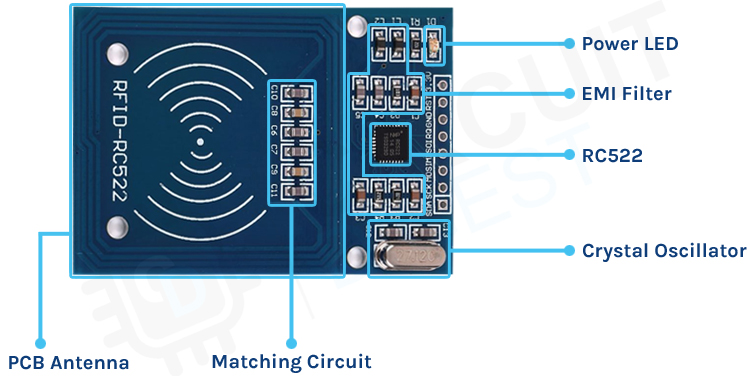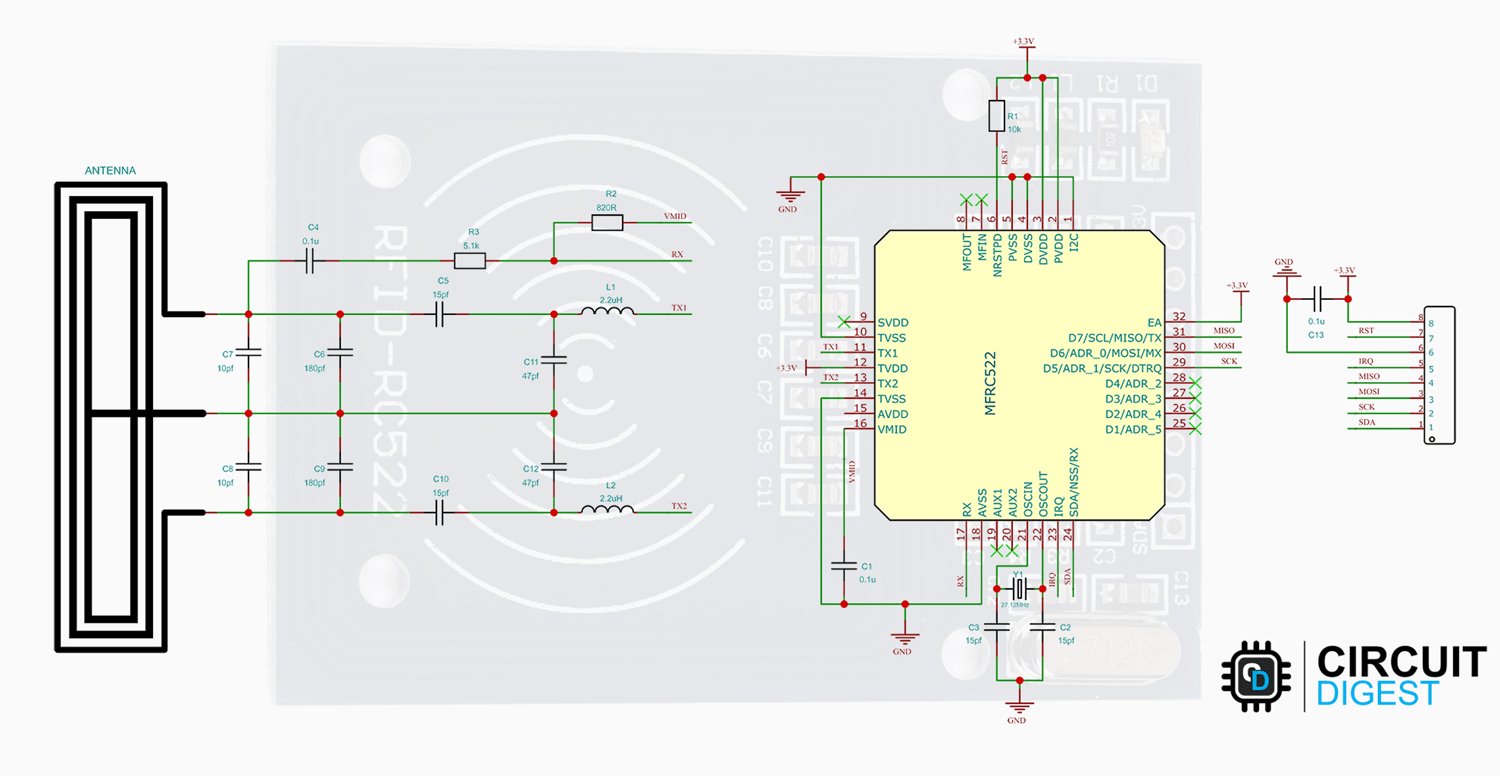
Have you ever wondered how the antitheft system in a supermarket works? Or how do automatic toll payment systems like fast tag work? All the answer to your doubts is RFID or Radio Frequency Identification. As the name indicates, RFID uses electromagnetic waves in the radio frequency spectrum for communication and data transfer. RFID tags are used in many industries and you can find them in product tags from stores to security access cards. RFID tags can expedite the checkout and can be used for antitheft measures. They can be also used for identifying livestock, products, etc. In this tutorial, we will learn how we can use the RFID technology with the Arduino. We will learn how to interface an RC522 RFID reader with the Arduino.
RC522 RFID Reader/Writer Module Pinout
The RC522 module has a total of 8 pins. This module supports various communication protocols and each pin has a different function for each communication protocol. The pinout of a RFID Reader module is as follows:

SDA SCL I2C Communication pins. DATA and CLOCK.
SS SCK MOSI MISO SPI communication pins. Slave Select, Clock, MOSI, and MISO.
RX TX UART Communication pins.
IRQ Interrupt signal from the module to indicate RFID tag detection.
GND Ground pin that needs to be connected to the GND pin on the Arduino.
RST Reset pin for the module
VCC Supply pin for the module. The supply voltage can be anywhere from 2.5V to 3.3V and must be connected to the 3.3V pin on the Arduino.
RC522 RFID Reader/Writer Module - Parts
The RC522 module consists of an MFRC522 RFID chip from NXP. It is clocked at 27.12MHz by the onboard crystal oscillator in the 49S package. The board also consists of the required EMI filter circuit and matching circuit. It also consists of a PCB antenna for communicating and energizing the RFID tags.
RC522 RFID Reader/Writer Module Circuit Diagram
The Schematic diagram for the RC522 module is given below. The circuit consists of bare minimum components. As we know the main component is the MFRC522 chip. The remaining components form the EMI filter along with the matching circuit for the antenna.
How is the RFID Works?
The RFID system is comprised of two components: the RFID reader and the tags. They are also called PCD (Proximity Coupling Device) and PICC (Proximity Integrated Circuit Card).
The RFID reader consists of an antenna to emit high-frequency EM waves and a reader/writer. MFRC522 from NXP is an example of such an integrated circuit. Since we are using high-frequency waves in the megahertz range, the size of the antenna can be small.
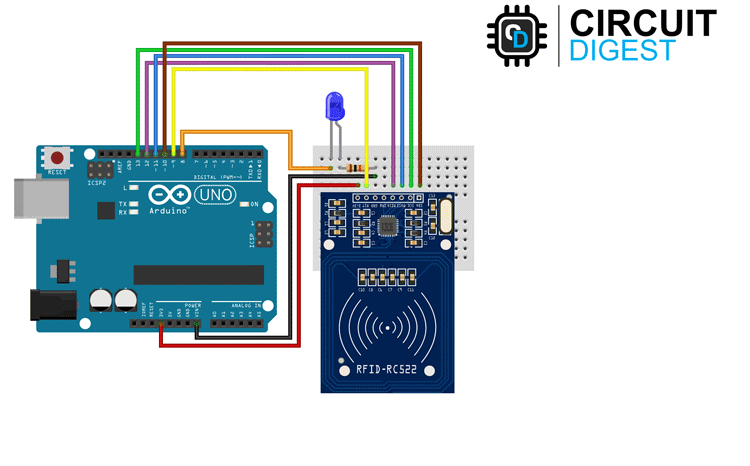
The RFID tag can be either passive or active. Active tags are powered by batteries while the passive RFID tags are powered by energy from the reader’s interrogating EM waves. The tags are available in different forms or shapes like cards, tags, key forbs, or stickers. Whatever the shape, the RFID tag will consist of an antenna and the RFID chip, which will store all the data. When triggered by an electromagnetic interrogation pulse from a nearby RFID reader, the tag will transmit data back to the reader. The reader will then analyze this data to identify the tag. Unlike a barcode or a QR code, the tag does not need to be within the reader’s line of sight. This makes it easier to process and can be used for tracking objects in closed space.
Commonly Asked Questions about RFID Reader
What is an RFID used for?
RFID tags are a type of tracking system that uses radiofrequency to search, identify, track, and communicate with items and people.
How is RFID used in healthcare?
RFID helps to mitigate drug counterfeiting, simplifies the clinical trial process, improves the accuracy of patient identification, eases inventory management, streamlines patient tracking, improves communications between caregivers and patients, and eradicates the risk of administering the wrong medications.
Can Wi-Fi interfere with RFID?
Interference from other radio-frequency (RF) emitting devices (RFI), such as other RFID readers and Wi-Fi access points, can negatively impact RFID system performance.
RC522 RFID Reader Module
The RC522 RFID module is based on the popular MFRC522 RFID reader chip from NXP. These modules are cheap and available from most online stores. MFRC522 is a highly integrated RFID reader/writer IC for contactless communication at 13.56 MHz. The MFRC522 reader supports ISO/IEC 14443 A/MIFARE and NTAG. The operating voltage of the RC522 module is 2.5V – 3.3V. Even though the maximum supply voltage is 3.3V the communication pins are 5V tolerant. So, we can connect the module directly to an Arduino without any Level-Shifters.
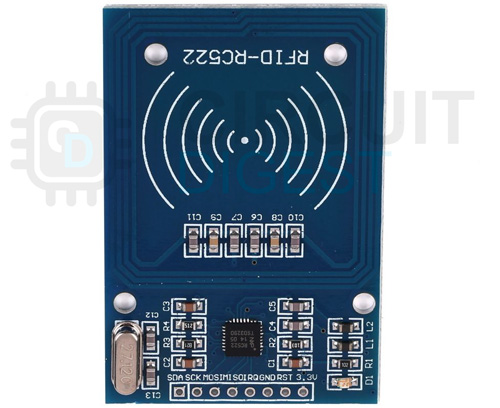
The MFRC522 supports three different communication protocols:
- SPI with Speed up to 10Mbit/s
- I2C interface with speed up to 400kBd in Fast mode and up to 3400kBd in High-Speed mode
- RS232 Serial UART with speed up to 1228.8kBd
The RC522 module usually comes with an RFID card and a key fob. And each of these comes with a 1KB of memory. We can not only read these tags but can also program these with the RC522 module. Here is the picture showing the tags along with the RC522 module.
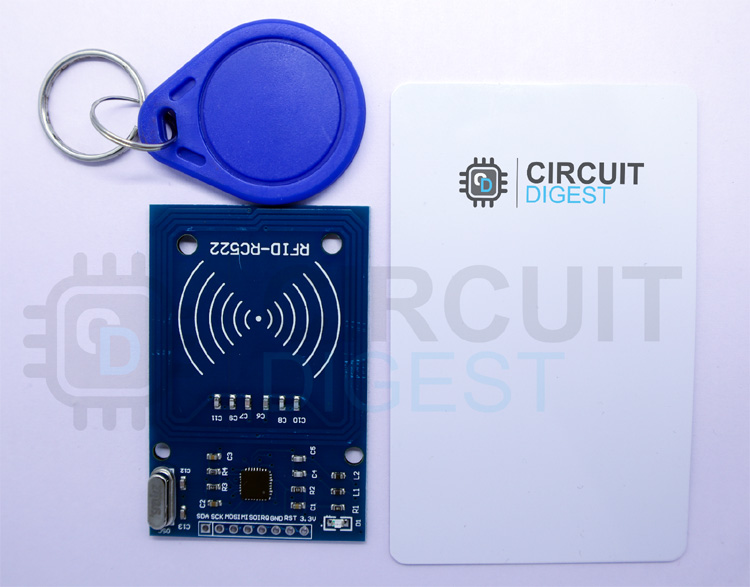
Arduino RC522 RFID Reader Interfacing Circuit Diagram
For interfacing the RC522 RFID module with the Arduino, we will be using the SPI interface. Follow the circuit diagram and make the connections as per that.
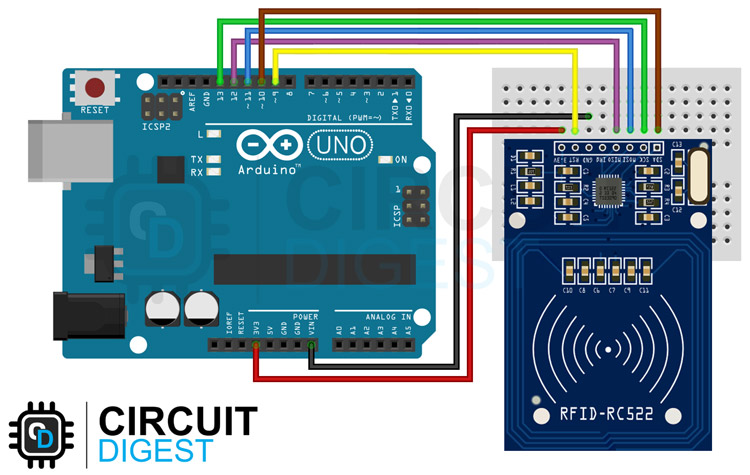
The VCC and GND pins of the module are connected to the 3.3V and GND pins of Arduino respectively. The Reset pin is connected to the D9 and SS, MOSI, MISO, and SCK pins are connected to the D10, D11, D12, and D13 pins of the Arduino respectively. The SS and RST pins are configurable and can be connected to any other digital pins on the Arduino.
Arduino RC522 RFID Module Code
As the connections are made, let’s look at the coding part. For that, we are going to use the MFRC522 Arduino Library by Miguel André Balboa. Since the library is not available in the Arduino library manager, download it from the MFRC522 GitHub repository and install it in the Arduino library folder. You can install it either through the Arduino IDE, by going to Sketch -> Include Library -> Add ZIP Library and selecting the downloaded .ZIP file, or by just simply extracting the Zip file into the Arduino library folder.
Once the library is installed, we can test our setup with an example code. For that, open the DumpInfo example from the MFRC522 library. Here is the example code.
#include <SPI.h>
#include <MFRC522.h>
#define RST_PIN 9 // Configurable, see typical pin layout above
#define SS_PIN 10 // Configurable, see typical pin layout above
MFRC522 mfrc522(SS_PIN, RST_PIN); // Create MFRC522 instance
void setup() {
Serial.begin(115200); // Initialize serial communications with the PC
while (!Serial); // Do nothing if no serial port is opened (added for Arduinos based on ATMEGA32U4)
SPI.begin(); // Init SPI bus
mfrc522.PCD_Init(); // Init MFRC522
delay(4); // Optional delay. Some board do need more time after init to be ready, see Readme
mfrc522.PCD_DumpVersionToSerial(); // Show details of PCD - MFRC522 Card Reader details
Serial.println(F("Scan PICC to see UID, SAK, type, and data blocks..."));
}
void loop() {
// Reset the loop if no new card present on the sensor/reader. This saves the entire process when idle.
if ( ! mfrc522.PICC_IsNewCardPresent()) {
return;
}
// Select one of the cards
if ( ! mfrc522.PICC_ReadCardSerial()) {
return;
}
// Dump debug info about the card; PICC_HaltA() is automatically called
mfrc522.PICC_DumpToSerial(&(mfrc522.uid));
}
Once it’s compiled and uploaded to the Arduino, open the serial monitor and show any tag near the RC522 module. When the tag is in the vicinity, the reader will read all the data from the tag and will dump it into the serial monitor as shown below.

The data dump will contain all the details like Card UID, Card SAK, PICC type, and all the memory maps. The UID or Unique ID is Unique for each tag as the name suggests. If you get any communication failed error, that’s because our serial baud rate is too slow. Increase the baud rate to 115200 in the code and it will resolve the issue. Here in the data dump, we can see that the PICC type is MIFARE 1KB. That means the tag contains a MIFARE chip with a memory of 1KB.
Writing data to the RFID tag
Now that we have dumped the factory data from the tag, let’s see how we can write some data to the card. For that use the following code.
#include <SPI.h> //include the SPI library
#include <MFRC522.h> //include the MFRC522 RFID reader library
#define RST_PIN 9 //reset pin, which can be changed to another digital pin if needed.
#define SS_PIN 10 //SS or the slave select pin, which can be changed to another digital pin if needed.
MFRC522 mfrc522(SS_PIN, RST_PIN); // create a MFRC522 instant.
MFRC522::MIFARE_Key key; //create a MIFARE_Key struct named 'key' to hold the card information
byte data1[14] = {"Circuit-Digest"}; //The first data that needs to be written to the tag.
byte data2[12] = {"Jobit-Joseph"}; //The second data that needs to be written to the tag.
byte readbackblock[18]; //Array for reading out a block.
void setup()
{
Serial.begin(115200); // Initialize serial communications with the PC
SPI.begin(); // Init SPI bus
mfrc522.PCD_Init(); // Init MFRC522 card (in case you wonder what PCD means: proximity coupling device)
Serial.println("Scan a MIFARE Classic card");
for (byte i = 0; i < 6; i++)
{
key.keyByte[i] = 0xFF; // Prepare the security key for the read and write operations.
}
}
void loop()
{
// Look for new cards if not found rerun the loop function
if ( ! mfrc522.PICC_IsNewCardPresent()) {
return;
}
// read from the card if not found rerun the loop function
if ( ! mfrc522.PICC_ReadCardSerial())
{
return;
}
Serial.println("card detected. Writing data");
writeBlock(1, data1); //write data1 to the block 1 of the tag
writeBlock(2, data2); //write data2 to the block 2 of the tag
Serial.println("reading data from the tag");
readBlock(1, readbackblock); //read block 1
//print data
Serial.print("read block 1: ");
for (int j = 0 ; j < 14 ; j++)
{
Serial.write (readbackblock[j]);
}
Serial.println("");
readBlock(2, readbackblock); //read block 2
//print data
Serial.print("read block 2: ");
for (int j = 0 ; j < 12 ; j++)
{
Serial.write (readbackblock[j]);
}
Serial.println("");
//mfrc522.PICC_DumpToSerial(&(mfrc522.uid));//uncomment below line if want to see the entire memory dump.
}
//Write specific block
int writeBlock(int blockNumber, byte arrayAddress[])
{
//check if the block number corresponds to data block or triler block, rtuen with error if it's trailer block.
int largestModulo4Number = blockNumber / 4 * 4;
int trailerBlock = largestModulo4Number + 3; //determine trailer block for the sector
if (blockNumber > 2 && (blockNumber + 1) % 4 == 0) {
Serial.print(blockNumber);
Serial.println(" is a trailer block: Error");
return 2;
}
//authentication
byte status = mfrc522.PCD_Authenticate(MFRC522::PICC_CMD_MF_AUTH_KEY_A, trailerBlock, &key, &(mfrc522.uid));
if (status != MFRC522::STATUS_OK) {
Serial.print("Authentication failed: ");
Serial.println(mfrc522.GetStatusCodeName(status));
return 3;//return "3" as error message
}
//writing data to the block
status = mfrc522.MIFARE_Write(blockNumber, arrayAddress, 16);
//status = mfrc522.MIFARE_Write(9, value1Block, 16);
if (status != MFRC522::STATUS_OK) {
Serial.print("Data write failed: ");
Serial.println(mfrc522.GetStatusCodeName(status));
return 4;//return "4" as error message
}
Serial.print("Data written to block ");
Serial.println(blockNumber);
}
//Read specific block
int readBlock(int blockNumber, byte arrayAddress[])
{
int largestModulo4Number = blockNumber / 4 * 4;
int trailerBlock = largestModulo4Number + 3; //determine trailer block for the sector
//authentication of the desired block for access
byte status = mfrc522.PCD_Authenticate(MFRC522::PICC_CMD_MF_AUTH_KEY_A, trailerBlock, &key, &(mfrc522.uid));
if (status != MFRC522::STATUS_OK) {
Serial.print("Authentication failed : ");
Serial.println(mfrc522.GetStatusCodeName(status));
return 3;//return "3" as error message
}
//reading data from the block
byte buffersize = 18;
status = mfrc522.MIFARE_Read(blockNumber, arrayAddress, &buffersize);//&buffersize is a pointer to the buffersize variable; MIFARE_Read requires a pointer instead of just a number
if (status != MFRC522::STATUS_OK) {
Serial.print("Data read failed: ");
Serial.println(mfrc522.GetStatusCodeName(status));
return 4;//return "4" as error message
}
Serial.println("Data read successfully");
}
Once the code is compiled and uploaded, open the serial monitor. Then scan a tag with the module. The module will write two data to the tag and will read back once it’s written. This data will be then printed to the serial monitor. See the screenshot below.

Code Explanation
In the first lines, we have included the necessary libraries and defined the reset and SS pins. Since we are using the SPI protocol, we have included the SPI library and then the MFRC522 library for the RFID reader. The reset and SS pins can be connected to any other digital pin. The users may change it at their convenience.
#include <SPI.h> //include the SPI library #include <MFRC522.h> //include the MFRC522 RFID reader library #define RST_PIN 9 //reset pin, which can be changed to another digital pin if needed. #define SS_PIN 10 //SS or the slave select pin, which can be changed to another digital pin if needed.
Next, we have created the objects for the RFID reader library and declared the data that’s needed to be written. Also, declared an array to hold the data that was read from the tag.
MFRC522 mfrc522(SS_PIN, RST_PIN); // create a MFRC522 instant.
MFRC522::MIFARE_Key key; //create a MIFARE_Key struct named 'key' to hold the card information
byte data1[14] = {"Circuit-Digest"}; //The first data that needs to be written to the tag.
byte data2[12] = {"Jobit-Joseph"}; //The second data that needs to be written to the tag.
byte readbackblock[18]; //Array for reading out a block.
In the setup() function, we have initialized the serial communication, SPI, and the RFID reader library. We have also cleared the key array with blank data for reading and writing operations.
void setup()
{
Serial.begin(115200); // Initialize serial communications with the PC
SPI.begin(); // Init SPI bus
mfrc522.PCD_Init(); // Init MFRC522 card (in case you wonder what PCD means: proximity coupling device)
Serial.println("Scan a MIFARE Classic card");
for (byte i = 0; i < 6; i++)
{
key.keyByte[i] = 0xFF; // Prepare the security key for the read and write operations.
}
}
The function we are using to write data to the tag is the writeblock function. When this function is called, it will check if the provided block number corresponds to the data block or the trailer block. The trailer block will hold the Access Bit which controls the read and write access to the reaming blocks. Block number 3 is the trailer block. If the provided block number does not correspond to a data block, the function will return an error message. If it’s a data block, the function will authenticate the tag with a security key and if the authentication is successful, the data will be written to the corresponding block.
int writeBlock(int blockNumber, byte arrayAddress[])
{
//check if the block number corresponds to data block or triler block, rtuen with error if it's trailer block.
int largestModulo4Number = blockNumber / 4 * 4;
int trailerBlock = largestModulo4Number + 3; //determine trailer block for the sector
if (blockNumber > 2 && (blockNumber + 1) % 4 == 0) {
Serial.print(blockNumber);
Serial.println(" is a trailer block: Error");
return 2;
}
//authentication
byte status = mfrc522.PCD_Authenticate(MFRC522::PICC_CMD_MF_AUTH_KEY_A, trailerBlock, &key, &(mfrc522.uid));
if (status != MFRC522::STATUS_OK) {
Serial.print("Authentication failed: ");
Serial.println(mfrc522.GetStatusCodeName(status))
return 3;//return "3" as error message
}
//writing data to the block
status = mfrc522.MIFARE_Write(blockNumber, arrayAddress, 16);
//status = mfrc522.MIFARE_Write(9, value1Block, 16);
if (status != MFRC522::STATUS_OK) {
Serial.print("Data write failed: ");
Serial.println(mfrc522.GetStatusCodeName(status));
return 4;//return "4" as error message
}
Serial.print("Data written to block ");
Serial.println(blockNumber);
}
For reading data from the tag, we are using the readBlock function. It is similar to the write function. Once the function is called, it will determine the trailer block for the sector and then it will authenticate. If the authentication is successful, the function will read the data from the tag.
int readBlock(int blockNumber, byte arrayAddress[])
{
int largestModulo4Number = blockNumber / 4 * 4;
int trailerBlock = largestModulo4Number + 3; //determine trailer block for the sector
//authentication of the desired block for access
byte status = mfrc522.PCD_Authenticate(MFRC522::PICC_CMD_MF_AUTH_KEY_A, trailerBlock, &key, &(mfrc522.uid));
if (status != MFRC522::STATUS_OK) {
Serial.print("Authentication failed : ");
Serial.println(mfrc522.GetStatusCodeName(status));
return 3;//return "3" as error message
}
//reading data from the block
byte buffersize = 18;
status = mfrc522.MIFARE_Read(blockNumber, arrayAddress, &buffersize);//&buffersize is a pointer to the buffersize variable; MIFARE_Read requires a pointer instead of just a number
if (status != MFRC522::STATUS_OK) {
Serial.print("Data read failed: ");
Serial.println(mfrc522.GetStatusCodeName(status));
return 4;//return "4" as error message
}
Serial.println("Data read successfully");
}
In the loop function, the microcontroller will check if a tag is present or not periodically. If a tag is present and readable, the function will write two data arrays to the tag, and then it will read back and printed to the serial monitor.
void loop()
{
// Look for new cards if not found rerun the loop function
if ( ! mfrc522.PICC_IsNewCardPresent()) {
return;
}
// read from the card if not found rerun the loop function
if ( ! mfrc522.PICC_ReadCardSerial())
{
return;
}
Serial.println("card detected. Writing data");
writeBlock(1, data1); //write data1 to the block 1 of the tag
writeBlock(2, data2); //write data2 to the block 2 of the tag
Serial.println("reading data from the tag");
readBlock(1, readbackblock); //read block 1
//print data
Serial.print("read block 1: ");
for (int j = 0 ; j < 14 ; j++)
{
Serial.write (readbackblock[j]);
}
Serial.println("");
readBlock(2, readbackblock); //read block 2
//print data
Serial.print("read block 2: ");
for (int j = 0 ; j < 12 ; j++)
{
Serial.write (readbackblock[j]);
}
Serial.println("");
//mfrc522.PICC_DumpToSerial(&(mfrc522.uid));//uncomment below line if want to see the entire memory dump.
}
Turn On and Off LED with RFID
For this, connect an LED to the Arduino pin D8 through a current limiting resistor as shown below.
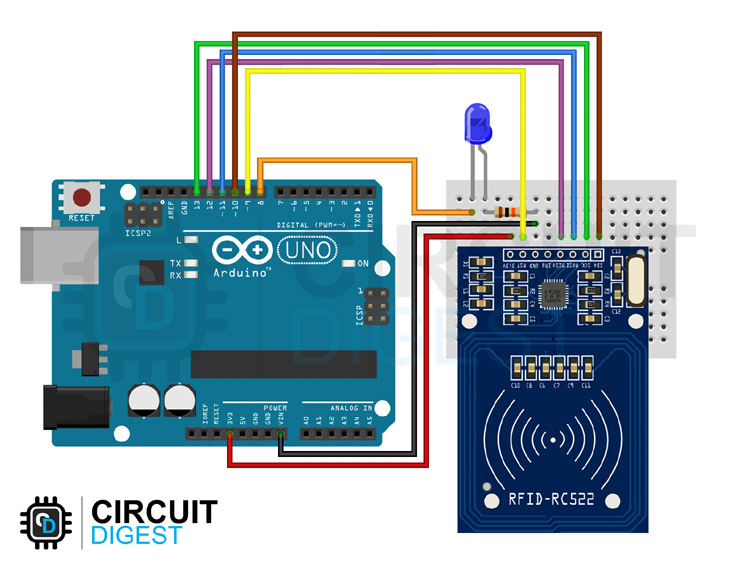
Arduino Code to Turn On or Off LED with RFID
Now let’s look at the code. The code is pretty simple. The RFID reader will check for any tags in the vicinity and if a tag is found, the reader will read the Unique ID from the tag. And if the UID matches with the UID in the code, the Arduino will toggle the LED state.
#include <SPI.h>
#include <MFRC522.h>
#define SS_PIN 10
#define RST_PIN 9
#define LED 8
byte readCard[4];
String tag_UID = "39C3BB99"; // Replace this with the UID of your tag!!!
String tagID = "";
MFRC522 mfrc522(SS_PIN, RST_PIN); // Create MFRC522 instance
void setup()
{
pinMode(LED, OUTPUT);// initialize digital pin LED_BUILTIN as an output.
digitalWrite(LED, LOW); // turn the LED off by making the voltage LOW
Serial.begin(115200); // Initialize serial communications with the PC
SPI.begin(); // SPI bus
mfrc522.PCD_Init(); // Initialise MFRC522
}
void loop()
{
//Wait until new tag is available
while (readID()
{
if (tagID == tag_UID)
{
digitalWrite(LED, !digitalRead(LED)); // Turn on or off the onboard led
}
}
}
//Read new tag if available
boolean readID()
{
//Check if a new tag is detected or not. If not return.
if ( ! mfrc522.PICC_IsNewCardPresent())
{
return false;
}
//Check if a new tag is readable or not. If not return.
if ( ! mfrc522.PICC_ReadCardSerial())
{
return false;
}
tagID = "";
// Read the 4 byte UID
for ( uint8_t i = 0; i < 4; i++)
{
//readCard[i] = mfrc522.uid.uidByte[i];
tagID.concat(String(mfrc522.uid.uidByte[i], HEX)); // Convert the UID to a single String
}
tagID.toUpperCase();
mfrc522.PICC_HaltA(); // Stop reading
return true;
}
Code Explanation
At first, we have included all the necessary libraries, declared the global variables, and created an instance for the RFID library.
#include <SPI.h> #include <MFRC522.h> #define SS_PIN 10 #define RST_PIN 9 #define LED 8 byte readCard[4]; String tag_UID = "39C3BB99"; // Replace this with the UID of your tag!!! String tagID = ""; MFRC522 mfrc522(SS_PIN, RST_PIN); // Create MFRC522 instance
Here the LED pin is connected to the Arduino pin D8. The tag_UID is unique for each tag and replace it with your own tag’s UID. You can get the UID by using the Dumpinfo example.
In the setup() function, we have initialized the pin D8 as an output and set its initial state to LOW. And then initialized the SPI bus and the MFRC522 instance.
void setup()
{
pinMode(LED, OUTPUT);// initialize digital pin LED_BUILTIN as an output.
digitalWrite(LED, LOW); // turn the LED off by making the voltage LOW
SPI.begin(); // SPI bus
mfrc522.PCD_Init(); // Initialise MFRC522
}
The function readID is used to get the UID from the tags. This function will check if a tag is available or not and if a tag is available, it will read the UID from the tag. Then the UID is converted to a string and it’s stored in a variable called tagID. The readID function will return true if the reading was a success.
boolean readID()
{
//Check if a new tag is detected or not. If not return.
if ( ! mfrc522.PICC_IsNewCardPresent()
{
return false;
}
//Check if a new tag is readable or not. If not return.
if ( ! mfrc522.PICC_ReadCardSerial())
{
return false;
}
tagID = "";
// Read the 4 byte UID
for ( uint8_t i = 0; i < 4; i++)
{
//readCard[i] = mfrc522.uid.uidByte[i];
tagID.concat(String(mfrc522.uid.uidByte[i], HEX)); // Convert the UID to a single String
}
tagID.toUpperCase();
mfrc522.PICC_HaltA(); // Stop reading
return true;
}
In the loop function, the Arduino will check for a valid tag reading periodically. If it receives a valid tag reading the read UID matches with the UID we have declared earlier, the LED state will be toggled.
void loop()
{
//Wait until new tag is available
while (readID())
{
if (tagID == tag_UID)
{
digitalWrite(LED, !digitalRead(LED)); // Turn on or off the onboard led
}
}
}
Projects Using RFID
There are some interesting projects done with the RFID. If you want to know more about those topics, links are given below.
This RFID Based IoT Enabled Event Management System not only monitors the entry log but with the help of IoT technology it can also send the Log and Entry data directly to a dedicated server that can handle all the authentication, authorization, and management making the whole process seamless.
In this RFID based Attendance System project, we will explain how we can count attendance automatically by using RFID cards. You can also find a step-by-step guide along with circuit and code to build your own attendance system.
Here in this project, we are using Arduino and relay to trigger the Electric Door Lock and RFID to authenticate, so your RFID tag will act as a key. If you place the wrong RFID card near the RFID reader a buzzer will beep to alert you about the wrong card.
Supporting Files
LED Control
#include <SPI.h>
#include <MFRC522.h>
#define SS_PIN 10
#define RST_PIN 9
#define LED 8
byte readCard[4];
String tag_UID = "39C3BB99"; // Replace this with the UID of your tag!!!
String tagID = "";
MFRC522 mfrc522(SS_PIN, RST_PIN); // Create MFRC522 instance
void setup()
{
pinMode(LED, OUTPUT);// initialize digital pin LED_BUILTIN as an output.
digitalWrite(LED, LOW); // turn the LED off by making the voltage LOW
SPI.begin(); // SPI bus
mfrc522.PCD_Init(); // Initialise MFRC522
}
void loop()
{
//Wait until new tag is available
while (readID())
{
if (tagID == tag_UID)
{
digitalWrite(LED, !digitalRead(LED)); // Turn on or off the onboard led
}
}
}
//Read new tag if available
boolean readID()
{
//Check if a new tag is detected or not. If not return.
if ( ! mfrc522.PICC_IsNewCardPresent())
{
return false;
}
//Check if a new tag is readable or not. If not return.
if ( ! mfrc522.PICC_ReadCardSerial())
{
return false;
}
tagID = "";
// Read the 4 byte UID
for ( uint8_t i = 0; i < 4; i++)
{
//readCard[i] = mfrc522.uid.uidByte[i];
tagID.concat(String(mfrc522.uid.uidByte[i], HEX)); // Convert the UID to a single String
}
tagID.toUpperCase();
mfrc522.PICC_HaltA(); // Stop reading
return true;
}
Write:
#include <SPI.h> //include the SPI library
#include <MFRC522.h> //include the MFRC522 RFID reader library
#define RST_PIN 9 //reset pin, which can be changed to another digital pin if needed.
#define SS_PIN 10 //SS or the slave select pin, which can be changed to another digital pin if needed.
MFRC522 mfrc522(SS_PIN, RST_PIN); // create a MFRC522 instant.
MFRC522::MIFARE_Key key; //create a MIFARE_Key struct named 'key' to hold the card information
byte data1[14] = {"Circuit-Digest"}; //The first data that needs to be written to the tag.
byte data2[12] = {"Jobit-Joseph"}; //The second data that needs to be written to the tag.
byte readbackblock[18]; //Array for reading out a block.
void setup()
{
Serial.begin(115200); // Initialize serial communications with the PC
SPI.begin(); // Init SPI bus
mfrc522.PCD_Init(); // Init MFRC522 card (in case you wonder what PCD means: proximity coupling device)
Serial.println("Scan a MIFARE Classic card");
for (byte i = 0; i < 6; i++)
{
key.keyByte[i] = 0xFF; // Prepare the security key for the read and write operations.
}
}
void loop()
{
// Look for new cards if not found rerun the loop function
if ( ! mfrc522.PICC_IsNewCardPresent()) {
return;
}
// read from the card if not found rerun the loop function
if ( ! mfrc522.PICC_ReadCardSerial())
{
return;
}
Serial.println("card detected. Writing data");
writeBlock(1, data1); //write data1 to the block 1 of the tag
writeBlock(2, data2); //write data2 to the block 2 of the tag
Serial.println("reading data from the tag");
readBlock(1, readbackblock); //read block 1
//print data
Serial.print("read block 1: ");
for (int j = 0 ; j < 14 ; j++)
{
Serial.write (readbackblock[j]);
}
Serial.println("");
readBlock(2, readbackblock); //read block 2
//print data
Serial.print("read block 2: ");
for (int j = 0 ; j < 12 ; j++)
{
Serial.write (readbackblock[j]);
}
Serial.println("");
//mfrc522.PICC_DumpToSerial(&(mfrc522.uid));//uncomment below line if want to see the entire memory dump.
}
//Write specific block
int writeBlock(int blockNumber, byte arrayAddress[])
{
//check if the block number corresponds to data block or triler block, rtuen with error if it's trailer block.
int largestModulo4Number = blockNumber / 4 * 4;
int trailerBlock = largestModulo4Number + 3; //determine trailer block for the sector
if (blockNumber > 2 && (blockNumber + 1) % 4 == 0) {
Serial.print(blockNumber);
Serial.println(" is a trailer block: Error");
return 2;
}
//authentication
byte status = mfrc522.PCD_Authenticate(MFRC522::PICC_CMD_MF_AUTH_KEY_A, trailerBlock, &key, &(mfrc522.uid));
if (status != MFRC522::STATUS_OK) {
Serial.print("Authentication failed: ");
Serial.println(mfrc522.GetStatusCodeName(status));
return 3;//return "3" as error message
}
//writing data to the block
status = mfrc522.MIFARE_Write(blockNumber, arrayAddress, 16);
//status = mfrc522.MIFARE_Write(9, value1Block, 16);
if (status != MFRC522::STATUS_OK) {
Serial.print("Data write failed: ");
Serial.println(mfrc522.GetStatusCodeName(status));
return 4;//return "4" as error message
}
Serial.print("Data written to block ");
Serial.println(blockNumber);
}
//Read specific block
int readBlock(int blockNumber, byte arrayAddress[])
{
int largestModulo4Number = blockNumber / 4 * 4;
int trailerBlock = largestModulo4Number + 3; //determine trailer block for the sector
//authentication of the desired block for access
byte status = mfrc522.PCD_Authenticate(MFRC522::PICC_CMD_MF_AUTH_KEY_A, trailerBlock, &key, &(mfrc522.uid));
if (status != MFRC522::STATUS_OK) {
Serial.print("Authentication failed : ");
Serial.println(mfrc522.GetStatusCodeName(status));
return 3;//return "3" as error message
}
//reading data from the block
byte buffersize = 18;
status = mfrc522.MIFARE_Read(blockNumber, arrayAddress, &buffersize);//&buffersize is a pointer to the buffersize variable; MIFARE_Read requires a pointer instead of just a number
if (status != MFRC522::STATUS_OK) {
Serial.print("Data read failed: ");
Serial.println(mfrc522.GetStatusCodeName(status));
return 4;//return "4" as error message
}
Serial.println("Data read successfully");
}

